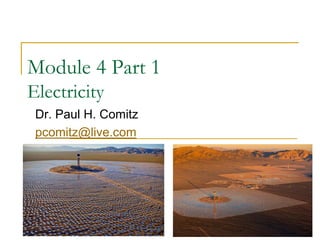
Electricity
- 1. Module 4 Part 1 Electricity Dr. Paul H. Comitz pcomitz@live.com
- 2. Agenda Electric Charge Coulombs Law The Electric Field Ohm’s Law Lab: Electricity http://phet.colorado.edu/sims/charges-and- fields/charges-and-fields_en.html
- 3. Course Modules # Module Weeks Reading Quiz 1 Newton's laws 1 Ch 4,5 * 2 Conservation of Energy and Momentum 2,3 Ch 6,7,8 Quiz 1 3 Thermodynamics 4,5 Ch 12,13,14 4 Electromagnetism 6,7 Ch 17,18 Quiz 2 5 Waves, Sound, and Light 8,9 Ch 16, 20, 21 Quiz 3 6 Modern Physics 10 Ch 23 Final Exam * it is strongly recommended you read chapters 0 - 3
- 4. Module 4 Reading: Chapters 17,18 Chapter 17 – Basic Electricity Chapter 18 = Magnetism Exercise 4, due start of week 8 (4%) Quiz 2 – next week in class Labs Electricity (3.75%) Electromagnetic Lab (3.75%)
- 5. Electric Force and Charge Central rule of electricity opposite charges attract one another; like charges repel
- 6. Electric Force and Charge Protons positive electric charges repel positives, but attract negatives Electrons negative electric charges repel negatives, but attract positives Neutrons neutral electric charge
- 7. Electric Force and Charge Fundamental facts about atoms 1. Every atom is composed of a positively charged nucleus surrounded by negatively charged electrons. 2. Each of the electrons in any atom normally has the same quantity of negative charge and the same mass.
- 8. Electric Force and Charge Fundamental facts about atoms (continued) 3. Protons and neutrons compose the nucleus. Protons are about 1800 times more massive than electrons, but each one carries an amount of positive charge equal to the negative charge of electrons. Neutrons have slightly more mass than protons and have no net charge. 4. Atoms usually have as many electrons as protons, so the atom has zero net charge.
- 9. Electric Force and Charge Ion positive ion—atom losing one or more electrons has positive net charge negative ion—atom gaining one or more electrons has negative net charge
- 10. Electric Force and Charge Electrons in an atom Examples: • When rubbing a comb through your hair, electrons transfer from your hair to the comb. Your hair has a deficiency of electrons (positively charged). • When rubbing a glass rod with silk, electrons transfer from the rod onto the silk and the rod becomes positively charged.
- 11. When you brush your hair and scrape electrons from your hair, the charge of your hair is A. positive. B. negative. C. both A and B D. neither A nor B Electric Force and Charge CHECK YOUR NEIGHBOR
- 12. When you brush your hair and scrape electrons from your hair, the charge of your hair is A. positive. B. negative. C. both A and B D. neither A nor B Comment: And if electrons were scraped off the brush onto your hair, your hair would have a negative charge. Electric Force and Charge CHECK YOUR ANSWER
- 13. Electric Force and Charge Conservation of Charge In any charging process, no electrons are created or destroyed. Electrons are simply transferred from one material to another.
- 14. Coulomb’s Law Coulomb’s law relationship among electrical force, charge, and distance discovered by Charles Coulomb in the 18th century states that for a pair of charged objects the force between them varies directly, as the product of their charges, and inversely, as the square of the separation distance electrical forces may be either attractive or repulsive
- 15. Coulomb’s Law Coulomb’s law (continued) If the charges are alike in sign, the force is repelling; if the charges are not alike, the force is attractive. in equation form: k = 9,000,000,000 Nm2/C2 unit of charge is coulomb, C
- 16. Coulomb’s Law
- 17. According to Coulomb’s law, a pair of particles that are placed twice as far apart will experience forces that are A. half as strong. B. one-quarter as strong. C. twice as strong. D. four times as strong. Coulomb’s Law CHECK YOUR NEIGHBOR
- 18. According to Coulomb’s law, a pair of particles that are placed twice as far apart will experience forces that are A. half as strong. B. one-quarter as strong. C. twice as strong. D. four times as strong. Coulomb’s Law CHECK YOUR ANSWER
- 19. Electric Field Electric field Charge exhibits an electric field space surrounding an electric charge (an energetic aura) describes electric force around a charged particle obeys inverse-square law force per unit charge
- 20. Electric Potential Electric potential difference Energy possessed by a charged particle due to its location in an electric field. Charge flows from higher potential to lower potential A difference in potential between two points charges in conductor flow from higher potential to lower potential maintained for continuous flow by pumping device A battery or generator can maintain a steady flow of charge
- 21. Electric Current Rate of electric flow measured in ampere (1 coulomb of charge per second) charge flows through a circuit; voltage is established across a circuit Relationship of current flow to material resistance and voltage (electrical potential) OHMS LAW V = IR
- 22. Ohm’s Law Ohm’s law relationship between voltage, current, and resistance states that the current in a circuit varies in direct proportion to the potential difference, or voltage, and inversely with the resistance
- 23. Ohm’s Law Ohm’s law (continued) in equation form: example: • for a constant resistance, current will be twice as much for twice the voltage • for twice the resistance and twice the voltage, current will be unchanged Resistors circuit elements that regulate current inside electrical devices = voltagecurrent resistance
- 24. Electric Circuits Circuits connected in two common ways series forms a single pathway for electron flow between the terminals of the battery, generator, or wall outlet parallel forms branches, each of which is a separate path for the flow of electrons
